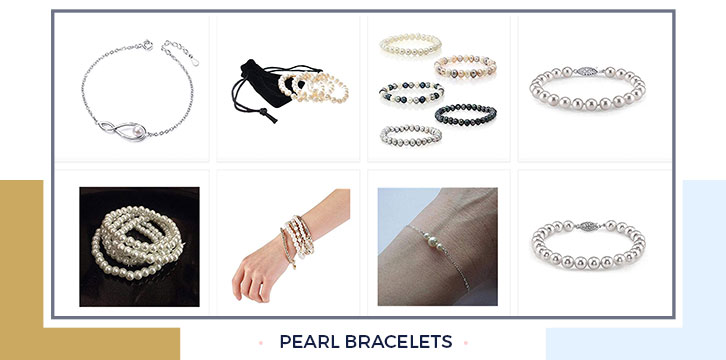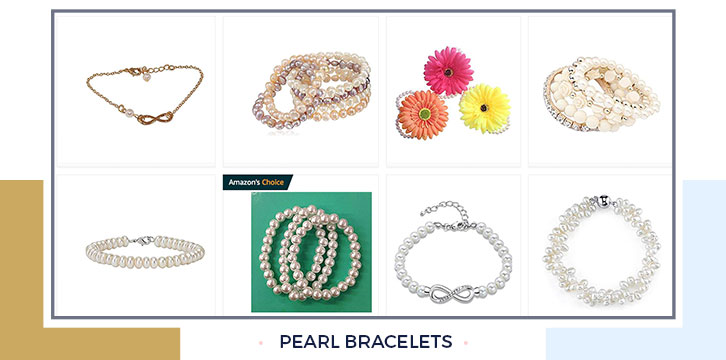Pearls are elegant, delicate, and above all, feminine, making pearl bracelets a great choice anytime you want to draw attention to your wrists. These bracelets come in many different, equally beautiful forms from cuffs to multi-strand bracelets to a bracelet version of the ever-popular tin cup pearl necklace. Furthermore, you can find them in any color under the sun.
Before you buy a bracelet, either as a gift for yourself or someone you love, think about the types of situations you might encounter. The most formal type of bracelet consists of a single strand with the classic Akoya pearls we know and love. However, there are many other types available as well. Double and triple strand bracelets look great when you want a piece of jewelry that’s a little less delicate. You can also find cuff bracelets that are decorated with pearls – these are a great option too! You might also consider “woven” bracelets which have many strands intertwined. Lastly, the most delicate pearl bracelet is the “tin cup.” This is a bracelet version of the popular necklace, consisting of pearls spaced along a fine chain or strand of silken thread at regular intervals. The result is strikingly feminine – one reason the trend has endured.

The most inexpensive type of pearl bracelets available are freshwater. While these are more casual than Akoya, they are much more affordable and often of equal quality. Freshadama pearls are nearly indistinguishable from Akoya and because they are all nacre (due to the cultivation process) they tend to be more durable. Freshwater pearls also come in a wide variety of colors from natural (pink, lavender, various pastels, and white), to dyed. What could be more feminine than a pink pearl bracelet, after all?
Akoya pearls are generally top of the line and are what everyone thinks of when they think of pearls – white, perfectly round, and with mirror-like luster. They do have some disadvantages, however. Because Akoya pearls are cultured using a beaded nucleus, they tend to have a thinner layer of nacre, which can lead to some wear and tear down the road. Also, even though the term Japanese Akoya pearls used to be an industry standard, today it is no longer considered valid due to the increase in Chinese production of Akoya pearls. One way to distinguish the two is the size – smaller Akoyas are generally Chinese, and sizes greater than 7-8mm are generally from Japan.
The most exotic pearl bracelets are made of Tahitian or South Sea pearls. Watch out though – their uniqueness and high quality may also come with a steep price tag. Tahitians are naturally dark, with various types of metallic overtone and body color combinations. Peacock, black, pistachio, aubergine, and chocolate are all popular colors that guarantee that anyone with a Tahitian pearl bracelet will stand out in a crowd. South Sea pearls are best known for their rich gold, but again, are very rare and expensive.
Pearls add an aura of mystery, elegance, and class to their wearer. Not only that, but a pearl bracelet is extremely feminine. Consider adding one to your jewelry collection – I’m sure you won’t regret it!
Pearl Bracelets
Pearls are elegant, delicate, and above all, feminine, making them pearl bracelets a great choice anytime you want to draw attention to your wrists. These bracelets come in many different, equally beautiful forms from cuffs to multi-strand bracelets to a bracelet version of the ever-popular tin cup pearl necklace. Furthermore, you can find them in any color under the sun.
Before you buy a bracelet, either as a gift for yourself or someone you love, think about the types of situations you might encounter. The most formal type of bracelet consists of a single strand with the classic Akoya pearls we know and love. However, there are many other types available as well. Double and triple strand bracelets look great when you want a piece of jewelry that’s a little less delicate. You can also find cuff bracelets that are decorated with pearls – these are a great option too! You might also consider “woven” bracelets which have many strands intertwined. Lastly, the most delicate pearl bracelet is the “tin cup.” This is a bracelet version of the popular necklace, consisting of pearls spaced along a fine chain or strand of silken thread at regular intervals. The result is strikingly feminine – one reason the trend has endured.
The most inexpensive type of pearl bracelets available are freshwater. While these are more casual than Akoya, they are much more affordable and often of equal quality. Freshadama pearls are nearly indistinguishable from Akoya and because they are all nacre (due to the cultivation process) they tend to be more durable. Freshwater pearls also come in a wide variety of colors from natural (pink, lavender, various pastels, and white), to dyed. What could be more feminine than a pink pearl bracelet, after all?
Akoya pearls are generally top of the line and are what everyone thinks of when they think of pearls – white, perfectly round, and with mirror-like luster. They do have some disadvantages, however. Because Akoya pearls are cultured using a beaded nucleus, they tend to have a thinner layer of nacre, which can lead to some wear and tear down the road. Also, even though the term Japanese Akoya pearls used to be an industry standard, today it is no longer considered valid due to the increase in Chinese production of Akoya pearls. One way to distinguish the two is the size – smaller Akoyas are generally Chinese, and sizes greater than 7-8mm are generally from Japan.
The most exotic pearl bracelets are made of Tahitian or South Sea pearls. Watch out though – their uniqueness and high quality may also come with a steep price tag. Tahitians are naturally dark, with various types of metallic overtone and body color combinations. Peacock, black, pistachio, aubergine, and chocolate are all popular colors that guarantee that anyone with a Tahitian pearl bracelet will stand out in a crowd. South Sea pearls are best known for their rich gold, but again, are very rare and expensive.
Pearls add an aura of mystery, elegance, and class to their wearer. Not only that, but a pearl bracelet is extremely feminine. Consider adding one to your jewelry collection – I’m sure you won’t regret it!

Caring for Simulated Pearls
A while back I explained how to care for pearls, which is important because they are fairly delicate gems. But what about simulated pearls? You would think that fake pearls would be much easier to store and clean but in fact many of the same rules apply, especially to Swarovski simulated pearls because they are very high quality and in many ways similar to the real thing.
Just like a regular pearl necklace, fake (or faux, or simulated) pearls should be put on last. Get dressed, put on makeup, perfume, etc. and then put on your simulated pearls. This is to avoid damaging the surface with acids/oils from your body or perfume. They should also be the first thing you remove. Just like natural pearls – “last on, first off” is the rule to remember.
It’s not as important to keep your simulated pearls away from heat or sunlight as it is with genuine pearls but I still wouldn’t cook with them or keep them on any longer than you really need to. That way they will look beautiful for quite some time.
When it comes to cleaning, again, you should be very careful with your artificial pearls. Unlike real pearls, they can handle a very small amount of (very) gentle detergent. However, it really is best to just buff them with a soft dry cloth as often as you can and save the cleaners for when they get extremely dirty.
Don’t store your necklace hanging up if at all possible, for the same reasons you want to avoid doing so with real pearls. You don’t want to damage the thread and have to restring or replace the necklace any sooner than you have to, right? Other than that, if you store your pearls in a jewelry box try to keep them separate or, ideally, store them in a soft cloth bag. As I mentioned earlier, Swarovski simulated pearls are quite high quality but some other faux necklaces may not be as durable and you want to keep them from getting scratched.
That’s really all you need to know here. Just follow the “last on, first off” rule to keep the finish of your necklace from getting damaged; try to avoid extreme heat though a little is okay; clean gently with a soft cloth or gentle cleaner; and, finally, store your artificial pearls by themselves in a jewelry box or in a soft bag to protect them. Sounds complicated but it’s really easy!
A Guide to Simulated Pearls
Overview
Simulated pearls have existed for over a thousand years. In fact, evidence suggests that people have been trying to produce imitation pearls since approximately 83 A.D. That’s when Chinese Philosopher Wang Chhung (or Wang Ch’ung) recorded his thoughts on how heating, proper timing, and the right mix of chemicals could be combined to form pearls that were quite close to the real thing. At the time, natural pearls were so rare and valuable that they were exorbitantly expensive. In fact, pearls were worth more than gold in many parts of the world, so it’s only natural that people would want to imitate the beauty of genuine pearls.
Experiments continued throughout the years with few mentions of imitation pearls. The Venetians discovered a method by which they could create beautiful iridescent glass in the 16th century, but the industry did not take off until finally a man named Jacquin discovered that the shimmer of fish scales could be used to create a substance known as “pearlessence” or “essence d’orient.” He was able to create simulated pearls by coating glass beads with essence d’orient and then filling them with wax. Unfortunately, getting the materials for pearlessence required harvesting scales from thousands of fish. These days, many faux pearls use other methods. For example, some manufacturers use plastic beads instead of glass. Also, while some companies still use pearlessence, others cover their beads in pearl film.
There’s nothing wrong with simulated pearls; in fact, well-made versions can be quite pretty. It can be helpful to know the different types on the market so that you know whether your pearls are real or not, however.
Types
If you are shopping for simulated pearls, you should look for strands that are labeled fake, faux, simulated, artificial, imitation, or man-made. Manufacturers and retailers are supposed to disclose this information, but unfortunately this doesn’t always happen. There are specific brands/types that are always artificial, including:
- Red Sea
- Laguna
- Mallorca/Majorica/Majorca
- LaTausca
- Shell (a specific type of artificial pearl)
- Pearlfection (more about them below)
- Mayoka (this might be the same as Majorca)
- Misaki
Swarovski (these are made of glass beads and are generally high quality in comparison to others)
Pearlfection has, in the past, been promoted in such a way that consumers might be confused. I’m not sure if this is on the company’s shoulders, or on the retailers/programs that promote them (QVC, etc). However, some of the claims I’ve heard are that these pearls are as much as 98% real, they are not imitation, their black pearls are from the Pinctada Margaritefera oyster (that produces black Tahitian pearls), a jeweler would not be able to tell whether their strand was real or not, and black is a natural color in Akoya pearls. Now, please be aware that none of these claims are true! Pearlfections pearls are indeed simulated.
Tests
What if you aren’t sure of the authenticity of your strand of pearls? Do you know how to tell the difference between real and fake pearls? Here are six common tests:
The tooth test. This one is something that many people in the industry swear by. To perform this test, run a pearl over your teeth (lightly!). Natural pearls should have a gritty feel, whereas simulated pearls should feel relatively smooth. The problem with this test is that cultured pearls tend to feel nearly as smooth as their man-made cousins. Basically, if your pearl(s) feel gritty, you’ve most likely got naturals; if they feel smooth, move on to another test.
Magnification. Under close inspection, real pearls should have ridges, grooves, or other surface imperfections. Simulated pearls are designed to be perfectly smooth. You should also inspect the drill holes carefully. The drill hole of a fake pearl will probably be ragged and uneven; you might even see some dye peeling around the edges.
Sunlight. Take your pearls out and look at them in the sun. Real pearls have more depth (due to the nacre) and color variation. Simulated pearls tend to have very little shine when compared to the real thing. They also lack that “inner glow” that pearls with very high luster possess. If you have a pearl necklace, take a look at several pearls in the same strand. Do they match exactly? If the colors are exactly the same, with little to no variation, chances are that your pearls are man-made.
Density. This one can be a bit tricky. In general, real pearls will feel heavier than simulated ones. High-quality artificial pearls may feel just like real pearls, unfortunately.
X-ray. If you’re willing to pay an expert to x-ray your pearls, this is the best test of all. An x-ray can tell you several things: whether your pearls are real, whether they are natural or cultured, and whether they have been dyed. This can be a bit expensive but is well worth the cost if you have any doubt.
Destructive tests. This category includes tests that most people wouldn’t care to perform. For example, you could try cutting your pearls open to see what the core looks like. Alternatively, you could try heat, water, or one of several other tests that involve destroying your pearls. If you want to try one of these in the name of science, go for it – but don’t try these if you want to wear your pearls ever again.
